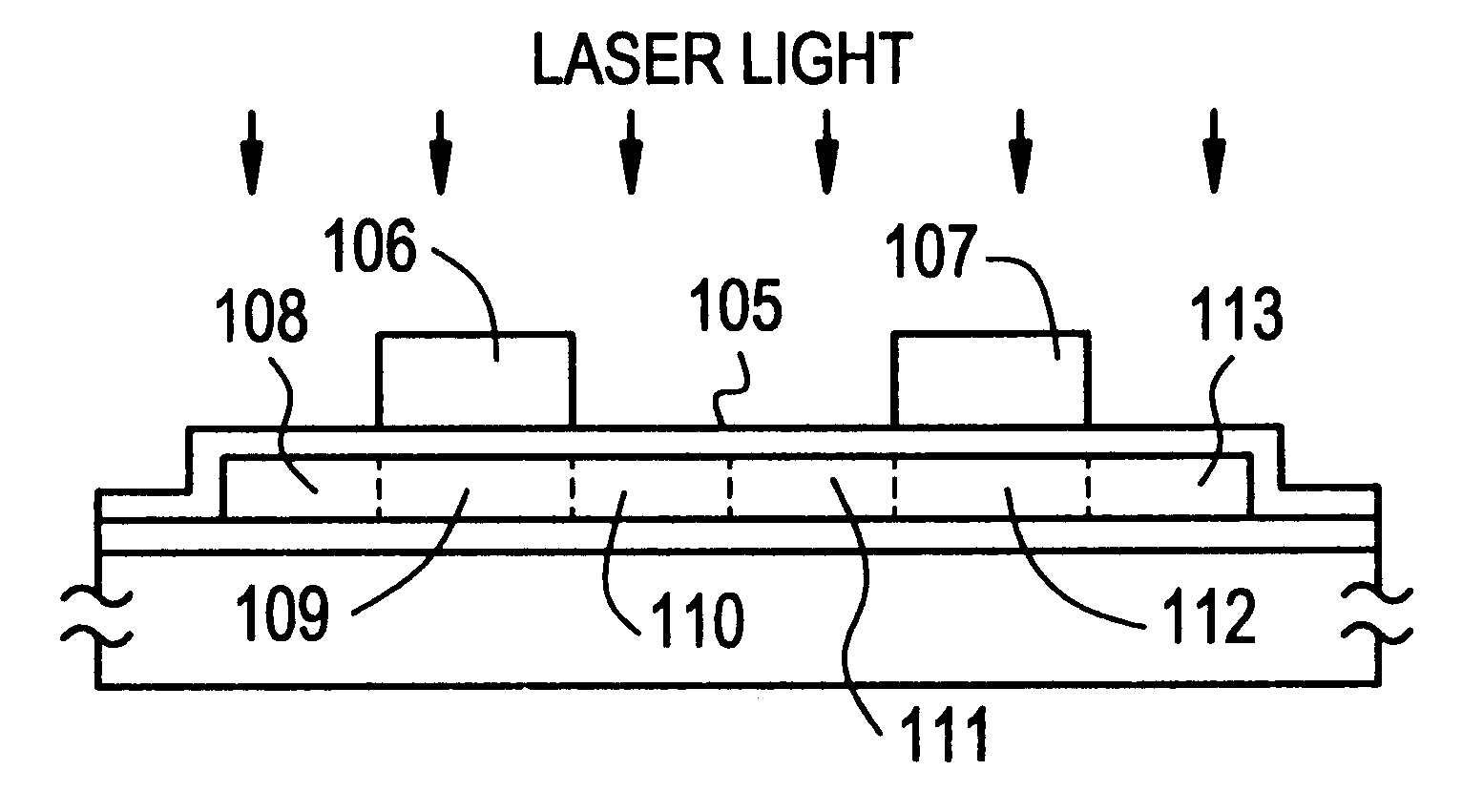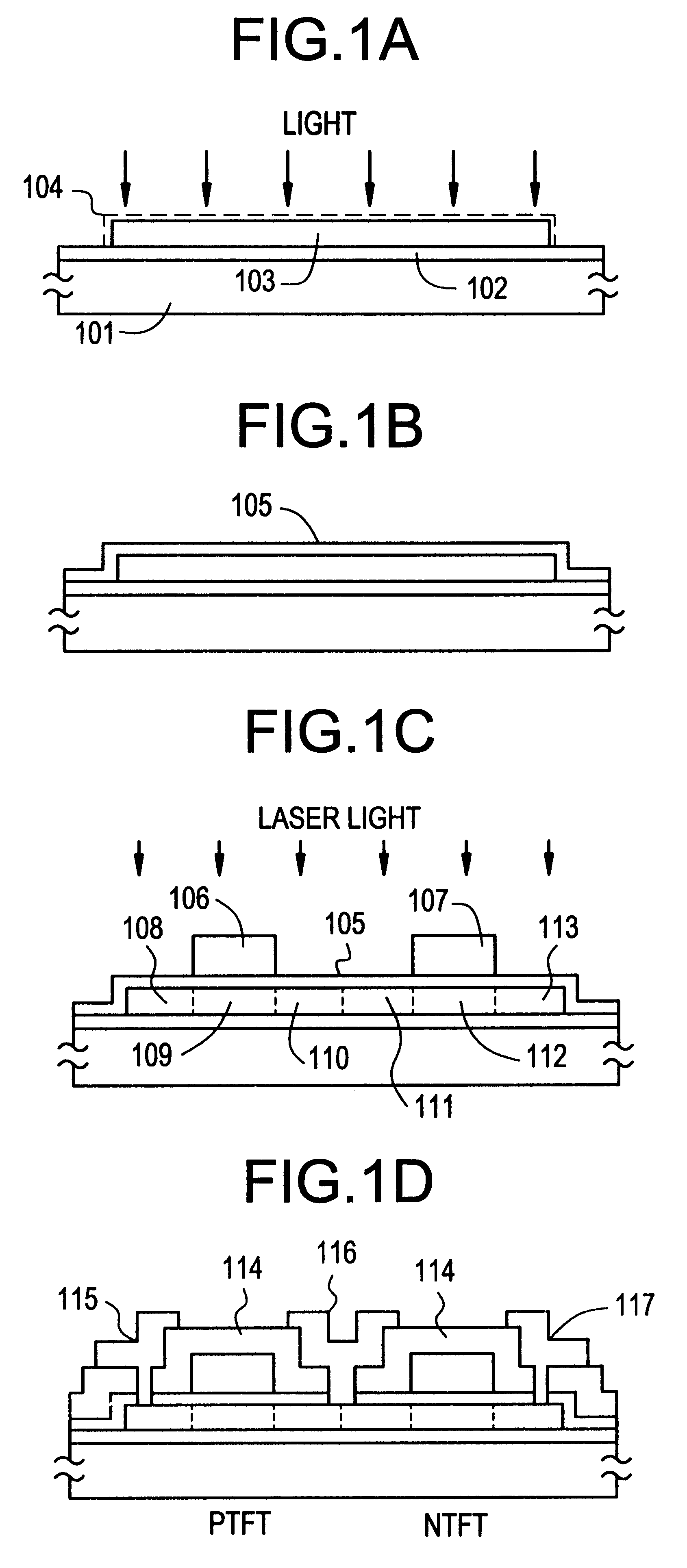Semiconductor device and method for manufacturing the same
- Summary
- Abstract
- Description
- Claims
- Application Information
AI Technical Summary
Benefits of technology
Problems solved by technology
Method used
Image
Examples
example 2
The present example refers to another complementary TFT circuit. Referring to FIG. 2, the present example is described in detail below. A Corning 7059 glass substrate 201 was annealed in the temperature range of from 620 to 660.degree. C. for a duration of 1 to 4 hours, gradually cooled at a rate of from 0.1 to 1.0.degree. C. / minute, preferably, at a rate of from 0.1 to 0.3.degree. C. / minute to a temperature in the range of from 450 to 590.degree. C., and was taken out from the heat treatment apparatus. A base film 202 was formed on the substrate thereafter, and an amorphous silicon film 203 was deposited at a thickness of from 300 to 800 .ANG. by plasma CVD. A nickel film from 20 to 50 .ANG. in thickness was deposited by sputtering in the region 205 using a silicon oxide mask 204 having a thickness of 1,000 .ANG.. The nickel film need not be a continuous film.
Then, the resulting structure was subjected to thermal annealing in a gaseous nitrogen atmosphere in the temperature range o...
example 3
FIGS. 5A-5G shows the step-sequential cross section structures obtained in the fabrication process according to the present example. A 2,000 .ANG. thick silicon oxide film was deposited as a base film 502 on a Corning 7059 glass substrate 501. The substrate was then annealed in the temperature range of from 620 to 660.degree. C. for a duration of 1 to 4 hours, gradually cooled at a rate of from 0.1 to 1.0.degree. C. / minute, preferably, at a rate of from 0.1 to 0.3.degree. C. / minute to a temperature in the range of from 450 to 590.degree. C., and was taken out from the heat treatment apparatus.
Then, a film of an intrinsic (I-type) amorphous silicon film was deposited by plasma-assisted CVD to a thickness of from 500 to 1,500 .ANG., for example, 1,000 .ANG.. The amorphous silicon film thus deposited was annealed for 48 hours at 600.degree. C. under a nitrogen inert gas atmosphere at the atmospheric pressure for crystallization. The silicon film thus obtained was then patterned to isl...
example 4
FIGS. 6A-6G show the step-sequential cross section structures obtained in the fabrication process according to the present example. A 2,000 .ANG. thick silicon oxide film was deposited as a base film 602 on a Corning 7059 glass substrate 601. The substrate was then annealed in the temperature range of from 620 to 660.degree. C. for a duration of 1 to 4 hours, gradually cooled at a rate of from 0.1 to 1.0.degree. C. / minute, preferably, at a rate of from 0.1 to 0.3.degree. C. / minute to a temperature in the range of from 450 to 590.degree. C., and was taken out from the heat treatment apparatus.
Then, a film of an intrinsic (I-type) amorphous silicon film was deposited by plasma-assisted CVD to a thickness of from 500 to 1,500 .ANG., for example, 1,000 .ANG.. The amorphous silicon film, thus deposited crystallized in the same manner as in Example 2 by using nickel as a catalyst. Thus, the crystallization was effected for a duration of 4 hours at 550.degree. C. under a gaseous nitrogen ...
PUM
 Login to View More
Login to View More Abstract
Description
Claims
Application Information
 Login to View More
Login to View More - R&D Engineer
- R&D Manager
- IP Professional
- Industry Leading Data Capabilities
- Powerful AI technology
- Patent DNA Extraction
Browse by: Latest US Patents, China's latest patents, Technical Efficacy Thesaurus, Application Domain, Technology Topic, Popular Technical Reports.
© 2024 PatSnap. All rights reserved.Legal|Privacy policy|Modern Slavery Act Transparency Statement|Sitemap|About US| Contact US: help@patsnap.com










